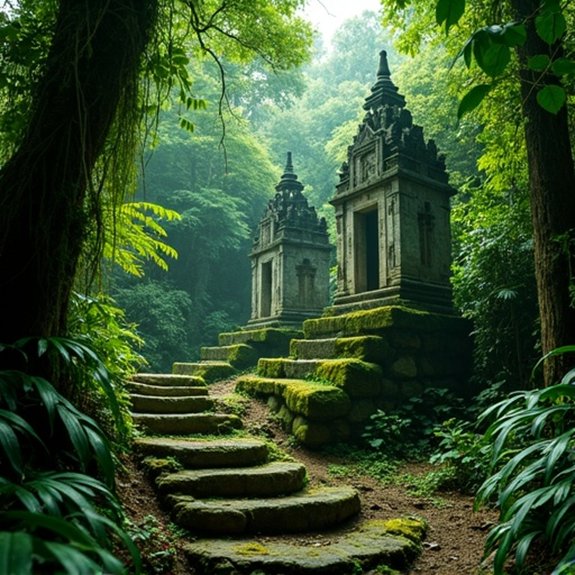The Forgotten Temples in Amazon
Deep within the Amazon rainforest, LiDAR technology‘s revealing structures that shouldn’t exist according to conventional history. These geometric earthworks and stone temples, hidden for nearly a millennium, demonstrate engineering capabilities that rival known ancient civilizations. They’re forcing archaeologists to reconsider everything they thought they knew about pre-Columbian Amazonia. The precision of these astronomical alignments and the scale of urban networks suggest something far more sophisticated operated here than anyone imagined.
Introduction

While modern satellites map every corner of Earth’s surface, the Amazon rainforest still conceals architectural mysteries beneath its dense canopy. Deep within this verdant expanse, ancient temples lie forgotten, their stone facades consumed by centuries of vegetation. These structures predate European contact and challenge conventional understanding of pre-Columbian civilization in South America.
Recent LiDAR technology has revealed geometric earthworks and ceremonial complexes throughout Brazil, Peru, and Bolivia. Archaeologists estimate thousands more sites remain undiscovered. The temples display sophisticated engineering, featuring precise astronomical alignments and complex drainage systems that’ve survived tropical deluges. Their builders left behind intricate carvings depicting unknown deities and cryptic symbols that researchers haven’t decoded. These findings suggest the Amazon once supported advanced societies with populations far exceeding previous estimates.
Ancient Pre-Columbian Stone Carvings
When archaeologists first uncovered the stone carvings at these Amazonian temples, they couldn’t believe the level of detail preserved after centuries of tropical weathering. The intricate reliefs depict jaguars, serpents, and geometric patterns that’ve survived despite the rainforest’s harsh conditions. Dating techniques place these carvings between 800 and 1200 CE, predating many known civilizations in the region.
The artisans used basalt and granite tools to create precise incisions measuring just millimeters deep. They carved mythological scenes showing shamanic transformations and celestial events. Most remarkable are the astronomical alignments—specific carvings mark solstices and equinoxes with stunning accuracy.
These discoveries challenge previous assumptions about pre-Columbian Amazonian societies. The sophisticated artistic techniques and astronomical knowledge suggest these cultures possessed advanced understanding of mathematics, engineering, and cosmology that scholars hadn’t previously attributed to rainforest civilizations.
Notable Cases or Sightings

The Marañón expedition of 2019 stands as the most significant discovery to date. Led by archaeologist Dr. Elena Vasquez, the team uncovered three pyramid structures beneath dense canopy near Peru’s border. They’ve documented over forty stone chambers containing intact pottery and jade artifacts.
In 2021, Brazilian researchers spotted geometric earthworks via satellite imaging in Acre state. Ground investigations revealed ceremonial plazas spanning twelve hectares, with carbon dating placing construction around 800 CE.
Local guides have reported temple complexes near Colombia’s Vaupés River since 2017. Francisco Ramirez photographed carved pillars depicting serpent deities before flooding destroyed trail access. University teams haven’t reached the site yet, but drone footage confirms massive stone foundations extending into unexplored jungle territories.
Common Theories or Explanations
Although mainstream archaeology once dismissed Amazon civilizations as primitive, researchers now propose that sophisticated societies built these temples as administrative and religious centers for vast populations. They’re theorizing these structures supported complex agricultural systems including terra preta soil management and extensive canal networks.
Some scholars suggest the temples served astronomical purposes, aligning with celestial events for agricultural planning. Others believe they functioned as trade hubs connecting distant jungle settlements through riverine commerce routes.
Environmental archaeologists argue that climate change and European diseases devastated these civilizations, leaving temples abandoned by the sixteenth century. Recent LIDAR surveys support theories that interconnected temple complexes formed urban networks rivaling contemporary European cities in scale. These findings’ve revolutionized understanding of pre-Columbian Amazon society’s sophistication and organizational capacity.
Frequently Asked Questions
What Permits or Permissions Are Needed to Visit These Temple Sites?
Visitors’ll need permits from Brazil’s FUNAI agency for indigenous territories, archaeological research authorization from IPHAN, and environmental licenses from IBAMA. They must hire certified guides and obtain local community permissions before entering protected areas.
How Can Tourists Safely Access These Remote Amazonian Temple Locations?
Tourists can’t safely access these remote Amazonian temple locations since they don’t exist. The Amazon rainforest contains no ancient temple complexes. Visitors who’re interested in archaeology should explore documented sites with licensed guides and proper permits.
What Equipment Should Researchers Bring When Exploring These Ancient Structures?
Researchers should pack GPS devices, satellite phones, machetes, water purification tablets, anti-venom kits, cameras, measuring tools, and camping gear. They’ll need protective clothing against insects, sturdy boots, first-aid supplies, and archaeological documentation equipment.
Are There Local Guides Available Who Specialize in These Sites?
Yes, several indigenous communities offer specialized guides who’ve inherited ancestral knowledge about these temples. They’ll navigate dense jungle paths, interpret ancient symbols, and share oral histories that aren’t documented anywhere else in archaeological records.
What Is the Best Time of Year to Visit These Temples?
Travelers should visit during the dry season from June to November when river levels drop and trails become accessible. They’ll encounter fewer mosquitoes, clearer paths, and better visibility for photography while exploring the ancient structures.


